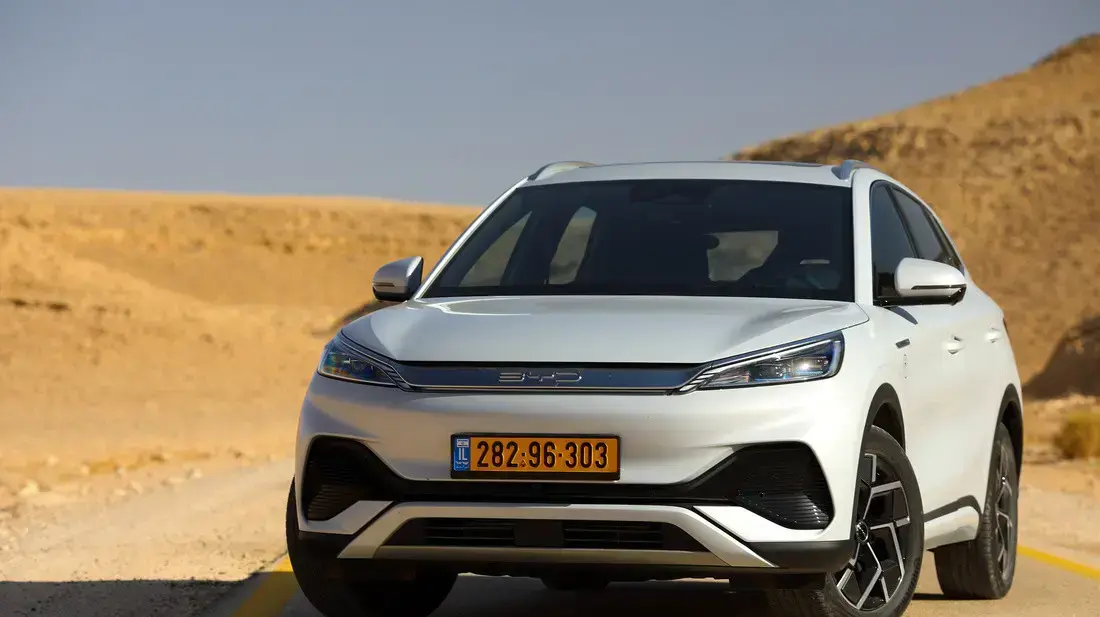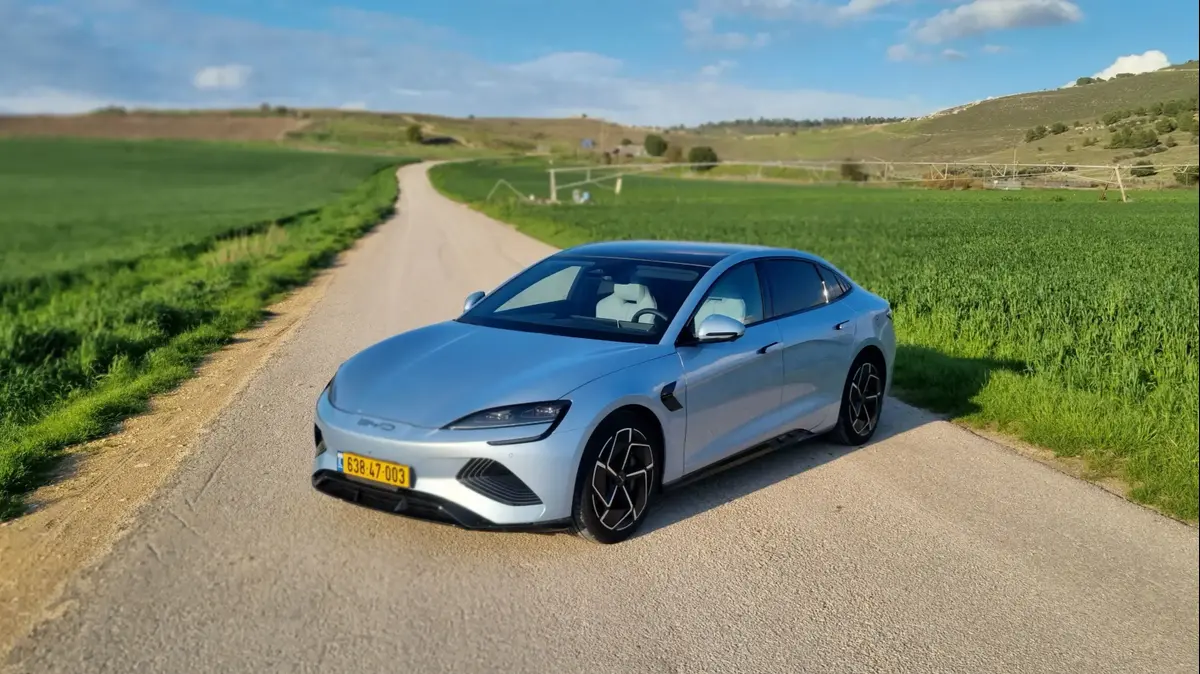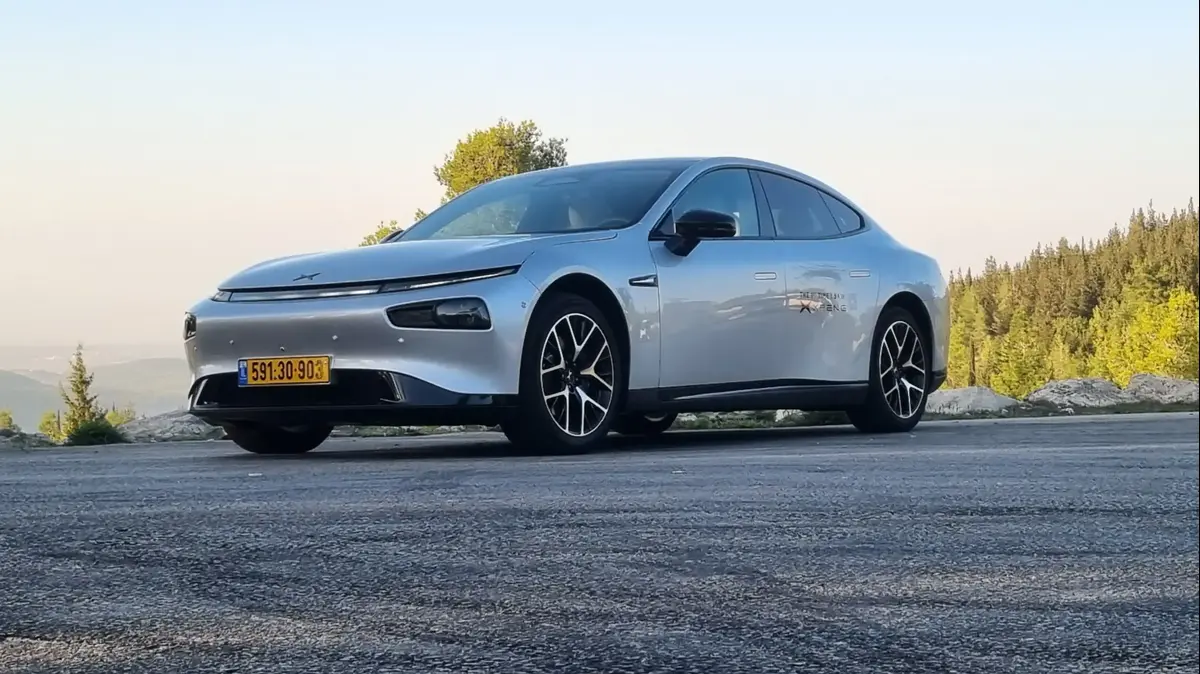First local test: BYD Auto 3
You may have already had the opportunity to read a "test" on the new BYD, but this time you received one that was conducted without the presence of the importer's representatives on a predetermined route.
Is a new star born in the local market and what are the reservations?
Yoav Falls
09/18/2022
Sunday, September 18, 2022, 02:20 Updated: 06:01
Share on Facebook
Share on WhatsApp
Share on Twitter
Share by email
Share in general
Comments
Comments
BYD Auto 3 (manufacturer)
The BYD ATTO 3 that was launched comes to the system for testing without the importer's representatives.
With your permission, from this moment on, his name in Israel is 'Ato 3'.
Those who haven't read about the launch are welcome to take a look here, and I apologize in advance for repeating some of the technical data.
The 'Ato 3' is an electric jeep in the C-Suv segment with a generous wheelbase of 2.72 meters, which implies in advance a good space in the passenger cabin.
The manufacturer is BYD, an old Chinese manufacturer, that is, not another technology company that decides one morning that it is also a vehicle manufacturer.
BYD has development centers in the West, and advanced batteries with BLADE technology that were also integrated into the 'Eto 3'.
Its technological background as a battery manufacturer is one of its strengths.
An elegant solution for the front with a strip in a metallic appearance (Photo: Yoav Foles)
The exterior design of the Auto 3 is quite successful in my opinion.
You won't find any controversial design elements in it, a bit generic, a bit Chinese, but handsome, and as a bonus it also managed to jump nicely over the front fence where many electric vehicles fall into the 'wait, there's no radiator to cool, so what do we do here?' trap, the solution: in the front of the car 3 Brushed aluminum strip with BYD letters in the center.
Many controversies have already revolved around the interior design.
Inside the vehicle there is almost no 'routine' component.
In front of the driver is a small 5-inch dashboard screen loaded with information.
The driver watches the screen from a three-spoke steering wheel, truncated in the lower part.
The dashboard itself looks like a sculpture of Salvador Dali if you asked him to make a car.
The upper part is a blue color that I didn't like the least, which seems to run a little in front of the driver and passenger.
Beneath it is a soft, light material, with stripes, and even pleasant to the touch.
In the center of the dashboard is the elephant in the room.
A 15.6-inch multimedia screen with a hysterical gimmick - it can be oriented horizontally or vertically with the push of a button.
By shifting to a vertical position, if you have sunglasses with polarization (polarization), the screen will be unreadable since the polarization on the screen will collide with the polarization on the glasses and the screen will appear completely dark.
(And thanks to the members of P.C. for the surprising discovery and the scientific explanation).
More in Walla!
The teachers who became models: "We never dreamed of participating in a fashion show"
In cooperation with foreign studies and Wizo Haifa
An interesting gimmick, but limits use with polarized sunglasses (Photo: Yoav Falls)
Under the screen - the air conditioning vents.
I admit that I did not like their design, and the material they are made of.
I also didn't like their location and the distribution of the cold air they tried to spread in the vehicle space.
Two of these under the screen, and two more on the sides of the dashboard.
Below the air conditioning vents is a wireless charging pad and then a central console with an unusual gear stick, somewhat reminiscent of the engine throttle of a modern airliner.
The P switch is located in a slightly strange location, at the base of the gear stick, close to the start and stop switch, and more than once drivers have confused the two switches.
Also on the central console are control switches for the regenerative braking (only two modes, with the strongest of them still quite weak), a driving mode selector - Eco, Normal and Sport, and deep compartments as cup holders.
Between the driver and passenger is a large, deep trunk with a lid that looks like it was taken from a Buick from the 1980s.
The unusual design also continues in the doors when the door opening handle is located in the upper part of a small and prominent speaker, and the open luggage compartment in the door gets a sort of 'closure' with three strings that no child who entered the car did not start strumming them as if they were a guitar.
"The guitar strings in the door" there was no one who did not try to play them (photo: Tomer Feder)
The rear seats are quite spacious, and thanks to a smart design, the vehicle floor is completely flat.
Those sitting in the back enjoy two air conditioning vents and two charging ports - USB and USB C. Also on the rear doors, the handles are mounted on small speakers + ambient lighting + a guitar in the doors.
The car has a partially opening panoramic roof with a useful curtain, of course fully electric, and with the ability to open by voice command Hi BYD.
The trunk with 440 liters is in the "standard" range of its category.
The cell floor can be adjusted to different heights and under it there is a designated place for the charging cable.
A spare wheel is not available.
The driver's seat is excellent, really, really good, so good that after driving a few hundred kilometers I got out of the car completely refreshed without a single sore back. Because it is so good and made my back comfortable, I forgive him for the two-tone upholstery with matching stitching Third.
If between the lines you were able to understand that I was less connected to the interior design, you are right.
However, in fairness I must report that my partner of 20 years and some loud shared offspring, as well as a friend with his toddler son found the cabin cool, fresh, youthful and fun to be in.
Air conditioning ports and charging sockets guarantee silence in the back (Photo: Yoav Falls)
An electric motor with a capacity of 204 hp and about 31 kg is responsible for the technical side.
The Atto 3's battery has a capacity of 60.5 kWh and is in BYD's unique blade technology. Front-wheel drive, and despite a curb weight of 1,750 kg, the Atto 3 flies itself from a standstill to 100 km/h in 7.3 seconds. Local tests with a system The built-in measurement in the car (a cool feature for psychic kids) produced lower results than this - once 6.9 seconds and another time 7.0 seconds to 100, and for fun it also reports 2.8 seconds to 50 km/h.
The suspension configuration is modern - McPherson in front and a multi-link suspension in the back.
This is the place to note that at BYD suspension calibration work is excellent.
The vehicle is very comfortable, does not crash on bumps, relatively soft, and still without too unusual roll angles.
Hato 3 brings with it a high road grip when the weak link is actually the steering wheel.
It has two modes for the driver to choose - normal and 'sport'.
The normal mode is too light and without any feedback to the driver, while the sport mode stiffens it and sharpens the response, but still does not convey to the driver any information about what is happening in the front wheels.
This is mainly relevant to the tenth percent of the population who wants the steering wheel to talk to them a little while driving.
All the rest will find it 'great'.
I turn and the vehicle turns - M.S.L (what should be).
The others will often find themselves understeer.
The ride comfort is good, the behavior is on the safe side of the spectrum, it's not exciting (Photo: Tomer Feder)
BYD officially claims a range of 420 km. In my estimation, this range is too optimistic. On a family trip with adaptive cruise control, aimed at 100 km/h, and exactly 131 km long, the range decreased by 137 km, i.e. a deviation smaller than the declared range.
In aggressive / normal driving, the energy consumption was 18.8 kWh per 100 km, which would result in a realistic range of only 320 km. The truth is of course in the middle, and I guess that the realistic range of the Hato 3 will be around 350 - 380 km M.
Hato 3 can accept fast DC charging or AC charging.
In DC charging is limited to 90Kwh only.
It's fine, but not something to run to tell the guys.
If by now you got the impression that this is a decent car then you are not really wrong, however the car also has a number of 'faults', some of them may turn out to be deal breakers.
440 liters in the trunk, not unusual for his group (Photo: Yoav Falls)
First, the air conditioning - on a normal hot day, nothing extreme, the air conditioner had a hard time cooling the interior of the car as long as I was in somewhat slow city traffic.
Going to a highway significantly improved the cooling capacity.
This could be a problem in a hot country like Israel, but it is an easily solvable technical problem, and the technical experts would do well to take this into consideration.
The user interface of the multimedia system requires a version update.
It is currently without Android Auto or Apple CarPlay.
According to the importer's representatives, such an update is expected in the first quarter of 2023, and it will be performed by downloading an update directly to the vehicle without the need to visit a service point.
The interface itself is very cumbersome, unintuitive, and with so many options that the driver finds himself reading long messages instead of concentrating on driving.
In this case, I think the Less Is More approach is better.
We need to reduce the gap in the aspect of noise insulation (photo: Tomer Feder)
The screen itself is excellent and of high quality, perhaps the best quality I have come across in a car to date.
However, in the expensive Design version tested here the screen is 15.6, a round of several tens of kilometers in the larger TANG with a 12.8 screen brought me to the conclusion that the large screen is unnecessary. 360- and the selection options, which are very impressive and useful. The sound quality from the original speakers is excellent.
Also at the level of criticism, wind noise penetrates the car at high speed from the direction of the mirrors. Maybe because the car is quite silent, then you notice the wind noise penetrating, but the reason doesn't really matter, at some point it was disturbing .
Not that a model will rise and fall on this, but Hato 3 is generally agile and more agile than its competitors (Photo: Tomer Feder)
Lato 3 has full safety systems, and accordingly it receives a score of 7 in the Ministry of Transportation's safety specifications.
However, some of the systems work incompletely, such as maintaining a lane that does not recognize the shoulder strip on the right.
The vehicle has not yet been tested in Western crash tests, and according to the importer, it is currently facing the cruelest of them - the EuroNcap.
When results are received - we will report back.
The price of the Hato 3 in the base version is NIS 156,000, while the design version tested here costs NIS 165,000.
It was possible to continue analyzing and describing the Hatto 3 for several more pages, without any problem.
My bottom line is very simple - the Hato 3 is not perfect, however, it is a worthy, comfortable and spacious competitor in the popular streetcar segment against the electric MG ZS and the Geely Geometric C (which exceed it in range and fall short of it in performance) given full deliveries - the importer has a hit in hand.
Even in profile, a generic but handsome appearance (Photo: Yoav Foles)
On the technical side: BYD Auto 3
Engine, drive:
electric, single engine, front
Battery:
87.2 kWh
Power (hp):
204
Torque (kgm):
31.6
Gearbox:
automatic single ratio
Dimensions:
Length (cm):
446
Width ( cm):
188
Height (cm):
162
Wheelbase (cm):
272
Trunk (liters):
440
Performance:
Acceleration 0-100:
7.3 seconds
Maximum speed:
No data
Range (test):
350 -380 km
Competitors:
MG ZS EV, Geely Geometric C
Price:
NIS 165,000 (test), NIS 156,000 (base)
vehicle
Vehicle tests
Tags
byd
electric car
electric car
Crossover








